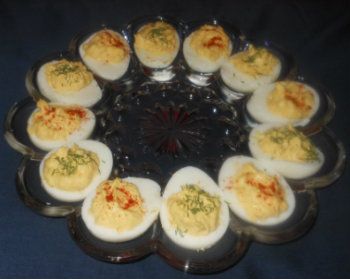In past blogs, I've passed on my favorite recipe for Oyster Stuffing, written one thing or another about; turkeys, hams, sweet potatoes, mashed potatoes, corn casseroles, stuffings, external dressings, gravies, pies, and appropriate wine pairings, for Thanksgiving and/or other holidays. Often overlooked however, are those savory morsels which encourage socialization before the main meal. I'm, of course, referring to the appetizer.
The appetizer is typically a morsel served before a meal to either stimulate the appetite, or keep Uncle Verne and the kids out of the kitchen until the turkey's ready. The right appetizer can give guests a chance to mingle and socialize over a nosh, and can set the tone for the rest of the evening. Fortunately, such a bite need not be labor intensive.
One can go the basic cheese plate route, featuring three cheeses, each representing a different milk and level of hardness. Thus, a plate displaying; Smoked Cheddar (semi-hard cow's milk cheese), Roquefort (semi-soft sheep's milk cheese), Goat Brie (soft goat's milk cheese), some neutrally flavored crackers/toast points, slices of green pear or apple, and some salty nuts; will keep your guests stomachs from growling until the main meal is served.
Equally doable are:
- A Pickle Plate featuring dill pickles, sweet pickles, a variety of olives, pickled Peppadew and/or other pickled peppers
- A Celery Plate featuring halved celery stalks stuffed with a variety of things from peanut butter to cream cheese to pimento cheese (Most fillings should work as long as they're of a soft, BUT NOT RUNNY, consistency.)
- A Cheese Ball/Log & Crackers
- A Veggie Plate & Dip
- Shrimp Cocktail poured over Cream Cheese served with Crackers
- Etc...
No, the Deviled Egg wasn't on the Pilgrims' table in 1621. Actually, stuffed eggs may have been present in some form; recipes for stuffed spiced eggs date back to Ancient Rome. Yet, the term "deviled" first appeared, within the culinary realm, during the 18th century, in England, when it referred to spiced meats. The term wasn't applied to stuffed eggs though until the 1882 release of Common Sense in the Household: A Manual of Practical Housewifery, by Marion Harland. ~
"Recipe for Deviled Eggs
Boil six or eight eggs hard; leave in cold water until they are cold; cut in halves, slicing a bit of the bottoms to make them stand upright, a la Columbus. Extract the yolks, and rub to a smooth paste with a very little melted butter, some cayenne pepper, a touch of mustard, and just a dash of vinegar. Fill the hollowed whites with this, and send to table upon a bed of chopped cresses, seasoned with pepper, salt, vinegar, and a little sugar. The salad should be two inches thick, and an egg be served with a heaping tablespoonful of it. You may use lettuce or white cabbage instead of cresses." (p. 246)
The dish has undergone some major evolutionary changes since then, into the tangy creamy bites we know today. When Deviled Eggs first appeared at traditional Thanksgiving gatherings is unclear, at least I can't find reference to their first holiday appearance. Be that as it may, Deviled Eggs have become such a part of Thanksgiving that in 2009 16,000 people logged onto Allrecipes.com, the day before Thanksgiving, to find the recipe for Deviled Eggs.
The basic recipe is extraordinarily simple.
-
Basic Deviled Eggs
Ingredients:
6 eggs, hard cooked and peeled
1/4 cup mayonnaise
1 teaspoon yellow mustard
salt & pepper to taste
smoked paprika or chopped dill to garnish (optional)
Procedure:
Cut eggs in half. Arrange egg whites cut side up on a serving plate and put the yolks in a small mixing bowl. Mash yolks with fork then stir in mayonnaise and mustard. Mash and stir all ingredients together well until creamy smooth. Taste and add salt and pepper if desired. Spoon a little bit of the mixture into each egg white half, dividing mixture as evenly as possible between the eggs. Sprinkle eggs with smoked paprika or dill if desired. Serve immediately or refrigerate until ready to serve.
Yield: 12 deviled eggs
Recipe Notes: Most people find a need tweak this basic recipe depending on a number of factors. If your boiled yolks turn out to be a bit grainier than normal, you'll want to increase the mayonnaise content to reach the desired creamy consistency.
Some people adjust mustard levels up or down to suit their taste, or even substitute Dijon Mustard for a spicy kick. Spicy mustards are fine if you need that little extra oomph, but I'd personally steer clear of stone ground mustards just because they'll keep your yolk mixture from coming out as smooth as you want it to.
-
From that basic recipe, a myriad of creative variations have appeared in cookbooks and across the internet. Such variations include, but are hardly limited to:
There are literally hundreds of other recipes for the Deviled Egg on Google alone, the above links simply lead to variations which caught my eye for one reason or another. This Thanksgiving you can entertain your guests with the simple time honored version of the Deviled Egg, or mix & match a few of the more creative versions for a more memorable platter.
Basic Deviled Egg Recipe prints as page 3 for your fridge or recipe file.
-

My secret to Deviled Eggs? A splash of DILL pickle juice! ;-)
ReplyDeleteVery interesting! ;-)
ReplyDelete